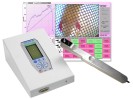Authors
V M Lopez-Alvarez, M Puigdomenech, X Navarro, A Cobianchi
Lab
nitat de Fisiologia Mdica, Facultat de Medicina, Universitat Aut˜noma de Barcelona, Spain.
Journal
Experimental Neurology
Abstract
This study characterizes the impact of increasing-intensity treadmill exercise (iTR) on noradrenergic (NE) and serotonergic (5HT) modulation of neuropathic pain. Following sciatic nerve transection and repair (SNTR) rats developed significant mechanical and thermal hyperalgesia that was partially prevented by iTR performed during the first 2Êweeks after injury. Marked decrease in the expression of 5HT2A and _1A and _-, but not _2A adrenergic receptors in the spinal cord dorsal horn was associated to SNTR and recovered by iTR, particularly in lamina II. iTR significantly increased 5HT2A in periaqueductal grey (PAG), raphe magnus (RM) and dorsal raphe nucleus (DRN), with a pattern suggesting reorganization of serotonergic excitatory interconnections between PAG and DRN. iTR also increased the expression of _1A in locus coeruleus (LC) and DRN, and _2 in LC, indicating that exercise enhanced activity of NE neurons, likely by activating autologous projections from DRN and PAG. iTR hypoalgesia was antagonized by blockade of _2 and 5HT2A receptors with administration of butoxamine and ketanserin. The neurotoxin DSP4 was injected to induce depletion of NE projections from LC before starting iTR. DSP4 treatment worsened mechanical hyperalgesia, but iTR hypoalgesia was similarly produced. Moreover, 5HT2A expression in LC further increased after DSP4 injection, all these results suggesting an intrinsic regulation of 5HT and NE activity between PAG, DRN and LC neurons activated by iTR. Finally, iTR significantly reduced microglial reactivity in LC and increased non-microglial BDNF expression, an effect that was reverted by butoxamine, implicating BDNF regulation in central 5HT/NE actions on neuropathic pain.
BIOSEB Instruments Used:
Electronic Von Frey 4 (BIO-EVF4),Electronic Von Frey 5 with embedded camera (BIO-EVF5)

 Douleur - Allodynie/Hyperalgésie Thermique
Douleur - Allodynie/Hyperalgésie Thermique Douleur - Spontanée - Déficit de Posture
Douleur - Spontanée - Déficit de Posture Douleur - Allodynie/Hyperalgésie Mécanique
Douleur - Allodynie/Hyperalgésie Mécanique Apprentissage/Mémoire - Attention - Addiction
Apprentissage/Mémoire - Attention - Addiction Physiologie & Recherche Respiratoire
Physiologie & Recherche Respiratoire
 Douleur
Douleur Système Nerveux Central (SNC)
Système Nerveux Central (SNC)  Neurodégénérescence
Neurodégénérescence Système sensoriel
Système sensoriel Système moteur
Système moteur Troubles de l'humeur
Troubles de l'humeur Autres pathologies
Autres pathologies Système musculaire
Système musculaire Articulations
Articulations Métabolisme
Métabolisme Thématiques transversales
Thématiques transversales SFN2024: Venez rencontrer notre équipe sur le stand 876 à Chicago
SFN2024: Venez rencontrer notre équipe sur le stand 876 à Chicago 
